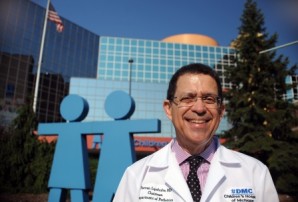
 After nearly three decades of continuing research into how chemotherapy frequently causes toxicity-related damage to the hearts of children who survive cancer, Steven Lipshultz, M.D., Wayne State University chair of pediatrics and pediatrician-in-chief at the Children’s Hospital of Michigan, part of the Detroit Medical Center, has published a breakthrough study demonstrating that a key drug designed to prevent such damage works effectively and safely.
After nearly three decades of continuing research into how chemotherapy frequently causes toxicity-related damage to the hearts of children who survive cancer, Steven Lipshultz, M.D., Wayne State University chair of pediatrics and pediatrician-in-chief at the Children’s Hospital of Michigan, part of the Detroit Medical Center, has published a breakthrough study demonstrating that a key drug designed to prevent such damage works effectively and safely.
Described by Dr. Lipshultz as “a significant step forward in helping children avoid the heart-damaging side effects that often accompany cancer chemotherapy,” the study in the authoritative Progress in Pediatric Cardiology journal is based in large part on numerous animal model and human clinical trials he performed or directed during the past 25 years.
The groundbreaking article http://www.sciencedirect.com/science/article/pii/S1058981314000083 answers a recently debated question about the efficacy of the drug dexrazoxane in suppressing the toxic effects of chemotherapy. The bottom-line conclusion: “Studies published since 2011 have confirmed the efficacy of dexrazoxane in preventing or reducing anthracycline-related cardiotoxicity in children with cancer. As a result, we believe that dexrazoxane should be available to children with high-risk cancers to reduce the risk of cardiotoxicity associated with high-dose anthracycline treatment.”
The study findings – many of them obtained by Dr. Lipshultz and his colleagues during their intensive research on cardiac ailments triggered by cancer therapy – also played a large role, he said, in the U.S. Food and Drug Administration’s (FDA) recent decision to award “Orphan Status” to the drug for the prevention of cardiomyopathy for children and adolescents 0 through 16 years of age treated with anthracyclines. That designation is “extremely important,” he added, in accelerating the process through which major pharmaceutical companies decide to seek FDA approval for and then manufacture the compound for the marketplace.
“I think our study is encouraging because of the way it will help to eventually bring the drug into the clinical setting, where it can protect the hearts of children who are undergoing cancer chemotherapy,” he said.
Dr. Lipshultz, a veteran pediatric cardiologist who 20 years ago led the effort to found the nation’s only registry of pediatric cardiomyopathy cases (the National Institutes of Health-funded North America Pediatric Cardiomyopathy Registry, or PCMR), also noted that the nation’s largest organization of pediatric oncologists, the Children’s Oncology Group, has now recommended using the drug to offset toxic effects of chemotherapy in childhood cancer survivors.
Dr. Lipshultz said the study offers “new hope” to the approximately 12,000 American children diagnosed with cancer and treated with chemotherapy each year. About half of them receive chemotherapy that may eventually result in the development of significant heart problems that can lead to shortened lifespans and reduced quality of life.”
“We’ve made terrific progress in the battle against childhood cancer during the past 40 years,” he added, “and the survival rate has more than doubled. But at the same time, we don’t want to be curing these kids of cancer only to see them develop heart problems because of their chemotherapy.”
“Unfortunately, there is no other drug to protect the hearts of children with cancer, which is why it’s so important that we develop dexrazoxane as a powerful tool that can accomplish that task. And it’s very encouraging to know that much of the research allowing that to happen has been performed by investigators right here at the Children’s Hospital of Michigan and Wayne State University. This new study provides a perfect example of how research conducted at the bedside, in a clinical setting, is crucial to accomplishing our mission of providing the very best possible care for patients.”
Said Dr. Lipshultz, who has received commendations from both the NIH and the U.S. Congress for his research in pediatric cardiology. “For a pediatrician whose passion is helping sick kids get better and go on to healthy lives, the publication of a study like this one is very rewarding indeed.”
###
About the Children’s Hospital of Michigan, www.childrensdmc.org
For more than 125 years, the Children’s Hospital of Michigan is the first hospital in the state dedicated exclusively to the treatment of children. With more than 40 pediatric medical and surgical specialties and services, the hospital is a leader internationally in neurology and neurosurgery, cardiology, oncology, and diagnostic services; it is ranked one of America’s best hospitals for children by US News and World Report and Parent Magazine and is recognized for quality and safety by the Leapfrog Group. The Children’s Hospital of Michigan is one of eight hospitals operated by the Detroit Medical Center (DMC).
About Wayne State University, www.wayne.edu
Wayne State University is a premier urban research institution offering more than 400 academic programs through 13 schools and colleges to nearly 32,000 students. Its School of Medicine is the largest single-campus medical school in the nation with more than 1,200 medical students. In addition to undergraduate medical education, the school offers master’s degree, Ph.D. and M.D.-Ph.D. programs in 14 areas of basic science to about 400 students annually.
